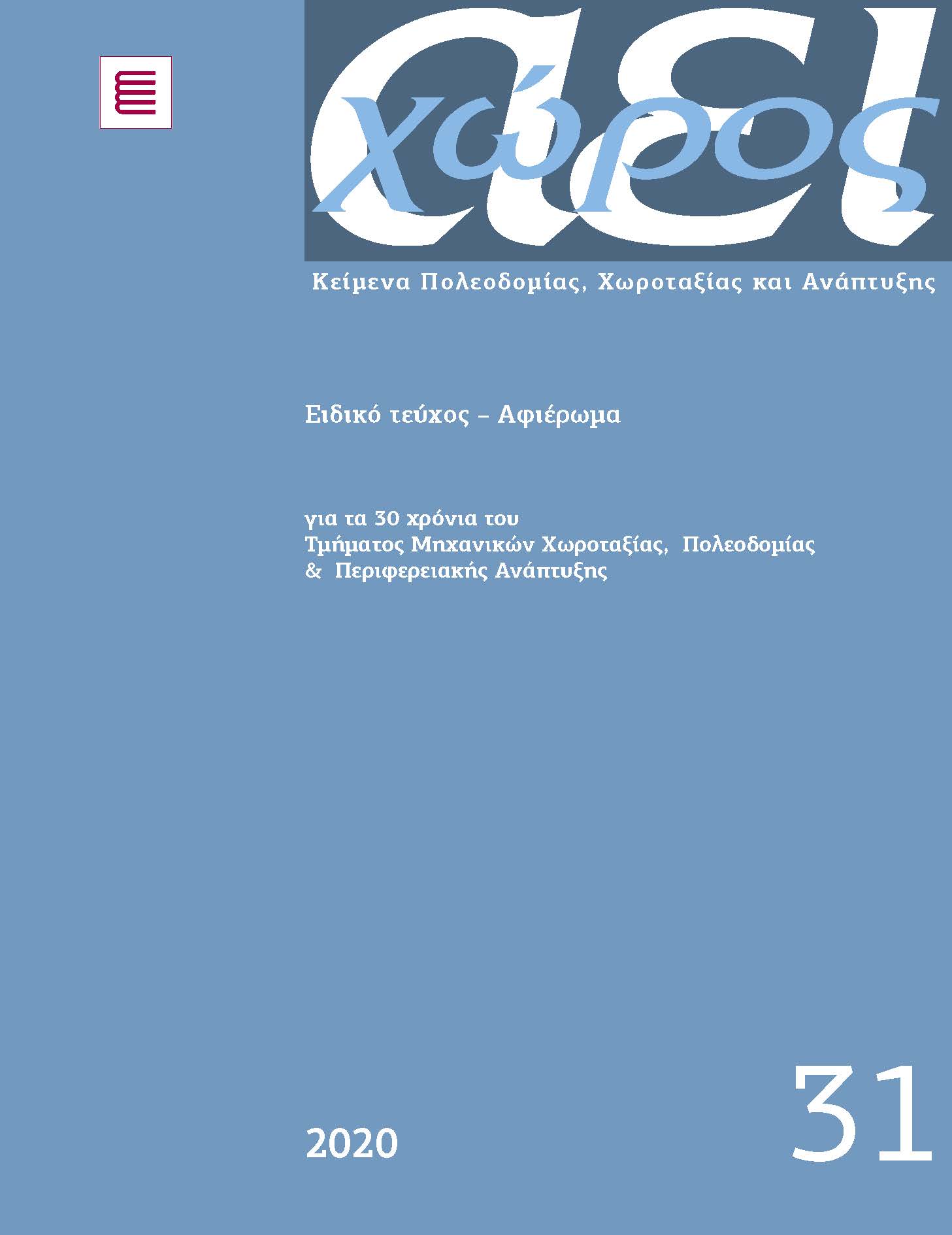Τα Σχέδια Βιώσιμης Αστικής Κινητικότητας (ΣΒΑΚ) και η συσχέτιση με το θεσμικό πλαίσιο χωρικού σχεδιασμού: ευρωπαϊκή και ελληνική πραγματικότητα
DOI:
https://doi.org/10.26253/heal.uth.ojs.aei.2020.45Λέξεις-κλειδιά:
Σχέδια Βιώσιμης Αστικής Κινητικότητας (ΣΒΑΚ), Θεσμικό πλαίσιο χωρικού σχεδιασμού, Πολεοδομικός σχεδιασμός, Στρατηγικός κυκλοφοριακός σχεδιασμόςΠερίληψη
Η διασφάλιση της βιώσιμης κινητικότητας στις αστικές περιοχές αποτελεί πρωταρχική επιδίωξη για την ευρωπαϊκή πολιτική με στόχο την επίτευξη της βιώσιμης ανάπτυξης και την βελτίωση της ποιότητας ζωής των κατοίκων των πόλεων. Στο πλαίσιο αυτό η ευρωπαϊκή πολιτική έχει προτείνει την εκπόνηση των Σχεδίων Βιώσιμης Αστικής Κινητικότητας (ΣΒΑΚ), ως στρατηγικών σχεδίων για τις αστικές περιοχές, με σκοπό την οργάνωση των βιώσιμων μετακινήσεων εντός των πόλεων αλλά και την βέλτιστη διασύνδεσή τους με τις ευρύτερες λειτουργικές περιοχές τους. Πολλές ευρωπαϊκές πόλεις έχουν προχωρήσει στην εκπόνηση τέτοιων σχεδίων αστικής κινητικότητας καθώς ο κυκλοφοριακός σχεδιασμός αποτελεί παράδοση σε χώρες όπως Γαλλία, Αγγλία, Γερμανία κ.ά. και εντάσσεται ως θεσμική υποχρέωση στο γενικότερο πλαίσιο του χωρικού σχεδιασμού, ενώ στη χώρα μας διαπιστώνεται διαχρονικά έλλειψη κυκλοφοριακού σχεδιασμού σε συντονισμό με τον χωρικό σχεδιασμό. Η παρούσα εργασία αναλύει το ευρωπαϊκό πλαίσιο και τους στρατηγικούς στόχους εκπόνησης των ΣΒΑΚ και ιδιαίτερα εξετάζει το θεσμικό πλαίσιο ένταξής τους στο σύστημα χωρικού σχεδιασμού στην Γαλλία. Επίσης, εξετάζει την ισχύουσα πολεοδομική νομοθεσία στη χώρα μας και την συσχέτιση με τον κυκλοφοριακό σχεδιασμό καθώς επίσης και την πρόσφατη νομοθετική ρύθμιση (Ν. 4599/19, αρθ.22) για την ένταξη των ΣΒΑΚ στο θεσμικό πλαίσιο του χωρικού σχεδιασμού. Στην πράξη διαπιστώνονται σοβαρές ελλείψεις κυρίως στο επίπεδο του στρατηγικού σχεδιασμού των μεταφορών καθώς και στη συσχέτισή του με τον χωρικό σχεδιασμό.
Λήψεις
Αναφορές
Ελληνόγλωσση
Αθανασόπουλος, Κ. (2009) Προς μια μέθοδο ένταξης των πολιτών στο σχεδιασμό έργων και ο συμμετοχικός σχεδιασμός. Αθήνα: ΕΜΠ.
Αραβαντινός, Α. (2007) Πολεοδομικός σχεδιασμός: Για μια βιώσιμη ανάπτυξη του αστικού χώρου. Συμμετρία: Αθήνα.
Βλαστός, Θ. και Μηλάκης, Δ. (2006) Πολεοδομία vs μεταφορές: Από την απόκλιση στη σύγκλιση. Αθήνα: Παπασωτηρίου.
Γιαννόπουλος, Γ. (2010) Πρότυπες διαδικασίες και περιεχόμενα μελετών στον τομέα των μεταφορών: Τ. Α. Θεσσαλονίκη: ΙΜΕΤ.
Ευρωπαϊκή Επιτροπή (2009) Το Σχέδιο Δράσης για την αστική Κινητικότητα (COM (2009) 490, Βρυξέλλες.
Ευρωπαϊκή Επιτροπή (2010) ‘ΕΥΡΩΠΗ 2020’: Στρατηγική για έξυπνη, βιώσιμη και χωρίς αποκλεισμούς ανάπτυξη. COM(2010) 2020 τελικό.
Ευρωπαϊκή Επιτροπή (2010) Αποτελέσματα Σχεδίου Δράσης για αστική κινητικότητα.
Η Λευκή Βίβλος Μεταφορών (2011) Χάρτης πορείας για έναν Ενιαίο Ευρωπαϊκό Χώρο Μεταφορών: Προς ένα ανταγωνιστικό και ενεργειακά αποδοτικό σύστημα μεταφορών. COM (2011) 0144, Βρυξέλλες.
Η Πράσινη Βίβλος (2007) Προς μια νέα παιδεία αστικής κινητικότητας (COΜ (2007) 551, Βρυξέλλες.
ΣΕΣ (2015) ‘Οι θέσεις του Συλλόγου Ελλήνων Συγκοινωνιολόγων για τα ΣΒΑΚ’, τ. 192.
Τσουκαλά, Α. (2009) «Προς ένα πρότυπο ελληνικού σχεδίου αστικών μετακινήσεων». Στο 5ο Διεθνές Συνέδριο για την έρευνα στις Μεταφορές.
Χαϊνταρλής, Μ. (2017) Τα νομικά χωρικά εργαλεία στρατηγικού χαρακτήρα. Αθήνα: Νομική Βιβλιοθήκη.
Ελληνική νομοθεσία
Ν. 2742/99 για τον «Χωροταξικό Σχεδιασμό και την Αειφόρο Ανάπτυξη», Γενικό Πλαίσιο Χωροταξικού Σχεδιασμού και Αειφόρου Ανάπτυξης.
Υ.Α. 9572/1845/2000 «Τεχνικές Προδιαγραφές μελετών Γενικών Πολεοδομικών Σχεδίων (Γ.Π.Σ.) και Σχεδίων Οικιστικής Οργάνωσης Ανοικτής Πόλης (Σ.Χ.Ο.Ο.Α.Π.)» (ΦΕΚ 209/2000).
Υ.Α. 10788/2004 «Έγκριση πολεοδομικών σταθεροτύπων και ανώτατα όρια πυκνοτήτων, (ΦΕΚ 285/2004).
Ν. 4269/2014 «Χωροταξική και πολεοδομική μεταρρύθμιση – βιώσιμη ανάπτυξη».
Ν. 4447/2016 ‘Χωρικός σχεδιασμός, Βιώσιμη ανάπτυξη και άλλες διατάξεις’.
Υ.Α. (ΦΕΚ 1975, 2017) για «Τεχνικές Προδιαγραφές μελετών Τοπικών Χωρικών Σχεδίων (ΤΧΣ) του ν. 4447/2016.
Ν. 4599/19 ΦΕΚ40Α/19, αρ. 22 Σχέδια Βιώσιμης Αστικής Κινητικότητας.
Ξενόγλωσση
CERTU (2012) Le Plan de Déplacements Urbains (PDU): Pour une intégration des politiques de mobilité.
CERTU (2013) Mobilités et transports - le point sur: 30 ans de PDU en France. L’âge de la maturité.
Droit de l’Urbanisme, Dalloz 2015.
Durlin, (2018) “Assessing SUMP in France, converging approaches for a complex reality”. Στο 5th European Conference on SUMP, Nicosia 2018.
ECMT (2001) European Conference of Ministers of Transport.
ELTIS: The urban mobility observatory. Διαθέσιμο στο https://www.eltis.org/mobility- plans/sump-guidelines και https://www.eltis.org/sites/default/files/sump- guidelines-2019_mediumres.pdf.
Rupprecht Consult (2012) The state of the art of Sustainable Urban Mobility Plans. Διαθέσιμο στο https://www.rupprecht-consult.eu/project/sumps-up.html.
Rupprecht Consult (2012) Understanding of a SUMP. Διαθέσιμο στο https://www. rupprecht-consult.eu/project/sumps-up.html.
NECE (2015) Transforming our world: The 2030 sustainable development agenda. Διαθέσιμο στο https://www.un.org/sustainabledevelopment/ sustainable-development-goals/
Wefering, F. και Rupprecht, S. (2014) Developing and Implementing a SUMP. Brussels: E.C.


